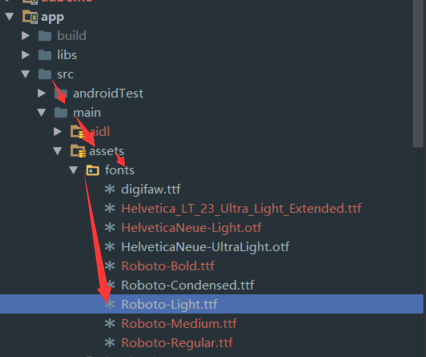Android系统中,默认提供三种字体: sans , serif , monospace
如果设置字体为系统字体之一,在XML中,直接设置字体格式:
1、sans
<TextView
Android:id="@+id/sans"
Android:text="sans"
Android:textSize="10sp"
Android:typeface="sans" />
<TextView
Android:id="@+id/monospace"
Android:text="monospace"
Android:textSize="10sp"
Android:typeface="monospace" />
3、serif
<TextView
Android:id="@+id/serif"
Android:text="serif"
Android:textSize="10sp"
Android:typeface="serif" />
使用自定义字体
首先要引入自定义的字体文件,例如引入Roboto-Light字体,将Roboto-Light.ttf放入assets\fonts\目录下
在XML布局中,不做任何修改:
<TextView
Android:id="@+id/textview "
Android:text="custom"
Android:textSize="10sp" />
得到TextView对象
TextView textView =(TextView)findViewById(R.id.textview);Typeface typeFace =Typeface.createFromAsset(getAssets(),"fonts/Roboto-Light.ttf");textView.setTypeface(typeFace);简单的三步,搞定。
2、上面是针对部分字体修改,但有时设计为了App的整体美观或者App产品本身的定位,绝大部分甚至所有字体,都需要使用自定义的字体。
如果再使用上面的方法逐一修改,对开发者来说无异于噩耗,而且,这种毫无意义的重复劳动,也不符合我们能懒就懒得程序员风格
那就想点省事的方法吧:
(1)、获取系统字体,并替换
public final class FontsOverride {
public static void setDefaultFont(Context context,
String staticTypefaceFieldName, String fontAssetName) {
final Typeface regular = Typeface.createFromAsset(context.getAssets(),
fontAssetName);
replaceFont(staticTypefaceFieldName, regular);
}
protected static void replaceFont(String staticTypefaceFieldName,
final Typeface newTypeface) {
try {
final Field staticField = Typeface.class
.getDeclaredField(staticTypefaceFieldName);
staticField.setAccessible(true);
staticField.set(null, newTypeface);
} catch (NoSuchFieldException e) {
e.printStackTrace();
} catch (IllegalAccessException e) {
e.printStackTrace();
}
public final class App extends Application {
@Override
public void onCreate() {
super.onCreate();
FontsOverride.setDefaultFont(this, "DEFAULT", "Roboto-Light.ttf");
}
}
(2)、上面是全局替换,但更多时候开发中只需要替换一部分,甚至有时想在XML中设置字体:
自定义CustomTextView对象
public class CustomTextView extends TextView {
public CustomTextView(Context context, AttributeSet attrs, int defStyle) {
super(context, attrs, defStyle);
init();
}
public CustomTextView(Context context, AttributeSet attrs) {
super(context, attrs);
init();
}
public CustomTextView(Context context) {
super(context);
init();
}
private void init() {
if (!isInEditMode()) {
Typeface tf = Typeface.createFromAsset(getContext().getAssets(), "Roboto-Light.ttf");
setTypeface(tf);
}
}
XML中使用自定义的CustomTextView
<com.packagename.CustomTextView
android:id="@+id/custom"
android:layout_width="match_parent"
android:layout_height="wrap_content"
android:text="Custom TextView"
android:textappearance="?android:attr/textAppearanceLarge"/>
如果使用自定义字体,则根据具体需求,选择对应的方法
原文地址